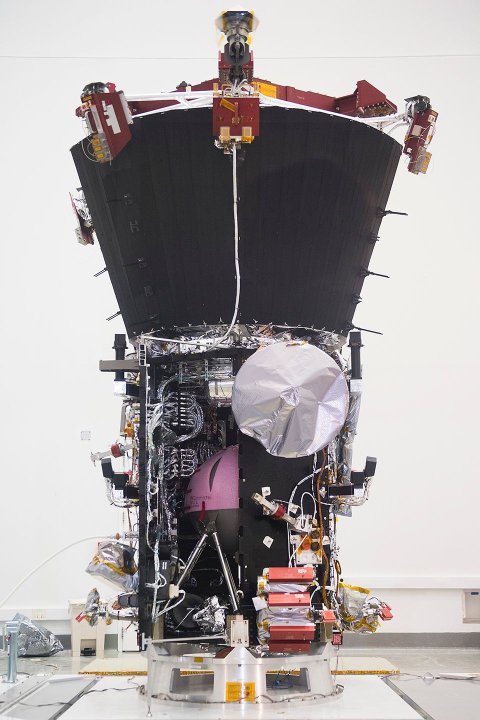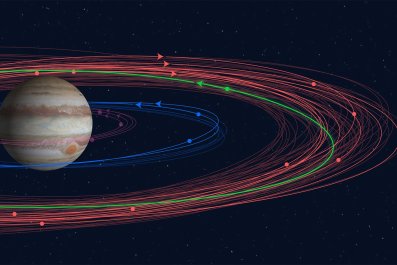When a campfire is too hot, take a step back. This advice is brought to you by common sense and basic physics. But here's a mystery: Why isn't this true for the sun, whose surface is actually cooler than its fiery atmosphere?
Eugene Parker was puzzling over this and other mysteries when he got his big eureka moment: The sun, he realized, emits a steady stream of hot particles that causes the northern lights and occasionally fries power grids and communications satellites. This "solar wind," as Parker called it, didn't exactly explain the campfire conundrum, but it earned the 30-year-old grad student a Ph.D. and a reputation as one of the foremost astronomers of all time.
The same year Parker published his work, in 1958, a group of scientists drew up a bucket list of 14 robotic space missions to various destinations in the solar system. Over the next 60 years, NASA sent ships to 13 of those places—the moon, the asteroids and every one of the known planets, from Mercury to Neptune, and even the dwarf planet Pluto. They explored the entire solar system, except the biggest, brightest and arguably most mysterious object at its center: the sun.
NASA is now making amends. On August 11, if all goes according to plan, a Delta IV heavy-lift rocket will blast off from Cape Canaveral, Florida, with a squatty probe the size of a Volkswagen in its nose cone. A special third-stage booster will push the probe out of Earth's orbit and send it zooming toward the sun at speeds of up to 430,000 mph, making it the fastest spacecraft ever flown. Its seven-year mission: to give scientists the closest look yet at the flaming enigma at the heart of our corner of the universe.
The mission is expected to help scientists understand how our star works and, by implication, the stars in distant reaches of the galaxy. "The sun is a natural lab that we cannot reproduce on Earth," says Nicholeen Viall, an astrophysicist at NASA's Goddard Space Flight Center. "We can see other stars and observe the light they emit but cannot send a probe to measure them." But we can measure the sun with Parker.
The mission, called the Parker Solar Probe, marks another milestone for NASA: It's the first time the agency has named a robotic probe after a living scientist: Eugene Parker, 91.

New Technology
What's kept NASA from sending a probe to the sun until now? Heat. To get close enough to make the trip worthwhile, a spaceship has to be able to endure extreme temperatures of 2,500 degrees Fahrenheit on its sun-facing side. That's 400 times more intense than any planetary probe has ever had to put up with, and hot enough to melt any of them. Before even considering sending a probe to the sun, NASA had to engineer a heat shield capable of protecting the delicate instruments—cameras, a particle sampler and devices to measure electric and magnetic fields—that make up the probe's innards. "We had to wait 60 years for technology to catch up with our dreams," says Nicky Fox, the probe's project scientist.
Parker Solar's heat shield is something of an engineering marvel. Resembling an oddly shaped 8-foot Frisbee, it is made of two layers of a superheated and extremely durable carbon-carbon composite (similar to what is used in golf clubs and tennis rackets), with a lightweight 4.5-inch carbon foam core, of which 97 percent is air. The whole thing weighs only 160 pounds. "It's a very lightweight way of making a very strong structure," says Betsy Congdon, the engineer who led the shield's development.
Another big challenge was keeping the solar cells that provide the spaceship with power from shutting down under the sun's intense radiation. NASA devised an active cooling system, which circulates a gallon of pressurized, purified water through vein-like chambers inside the solar panels. The panels are attached to robotic arms with joints that move much like the human shoulder, that will tuck the panels behind the shield when the heat gets too intense.
But heat wasn't the only issue: Outer space can get extremely cold, even near the sun. The team added heaters that keep the cooling system from icing over when the panels are in shadow.

Urgent Questions
Six weeks into its journey, Parker Solar will sail past Venus, the second planet from the sun (Earth is third), and six weeks after that it will make its first contact with the sun's corona, the hot, hazy atmosphere that surrounds it. The probe will follow a carefully planned cosmic choreography, taking 24 turns around the sun and seven close flybys of Venus.
Venus's gravity will slow the probe down, acting as a braking mechanism to keep it from plunging headlong into the sun. It will set the probe on a gentle spiral path, allowing it to glide near the solar surface—a mere 3.8 million miles away, seven times closer than any other spacecraft has come—for as long as possible, sending back data. When the mission ends in seven years, Parker will run out of fuel and burn up.
Scientists hope the probe will answer some urgent questions. For one, why does the sun occasionally spew large amounts of energetic particles millions of miles out into space, wreaking havoc on Earth? These enormous and unpredictable solar flares are part of the same process that also produces the much more benign solar wind, but that doesn't help much; scientists don't understand much about the solar wind either. Why, for instance, does the wind speed up as it leaves the sun, so that by the time it reaches Earth and other planets it is traveling faster than the speed of sound? They believe that powerful magnetic fields in the sun have something to do with it, but they lack a detailed understanding of how it all works.
"Ultimately, the energy that powers all the things like solar flares and solar wind is powered by the sun's magnetic field," says Viall. "Somehow the magnetic field is building up energy, storing it in the solar atmosphere and then releasing it."
With an onboard magnetometer, Parker Solar will measure the magnetic field and see what it looks like after that energy has been released, which will provide an important piece of the puzzle. By gathering such data, the probe will help improve our ability to predict space weather.

Another mystery the probe may help solve is why the sun's corona is so hot—an answer that eluded Eugene Parker 60 years ago. Even before probes ventured beyond the protective shroud of the Earth's magnetosphere, physicists knew that the area around the sun is approximately 300 times hotter than the star's surface. It's a situation that would appear to break the known laws of nature, says Fox, who works at Johns Hopkins University's Applied Physics Laboratory. But no one understood why. Parker proposed that the heating of the corona was caused by tiny explosions, called "nanoflares," on the sun's surface. Parker Solar will fly through the corona searching for evidence of such flares.
"Parker is like sticking a thermometer in the sun," says Viall. "We can take pictures and infer what the temperature was, but there's a lot of uncertainty that comes from only looking at pictures."
It won't take Parker Solar long to send back useful data. The probe will dive into the corona three months after launch, which means its first batch of data could come back by early December. That's a pretty quick turnaround as most space missions go.
And what does Eugene Parker, the probe's namesake and a professor emeritus at the University of Chicago, think of all this? "It's very exciting that we'll finally get a look at a region of space that has never been explored before," he tells Newsweek. "One would like to have some more detailed measurements of what's going on in the solar wind. I'm sure that there will be some surprises. There always are."
















